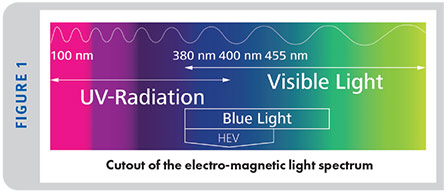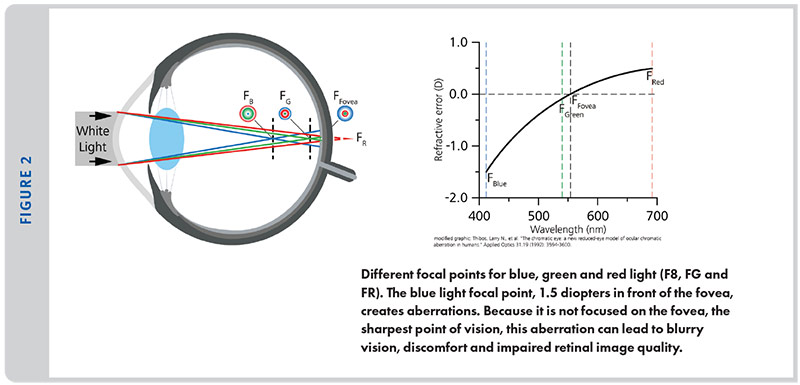
By Brent McCardle
Living in today’s media saturated world, we are barraged by blue light from LEDs, smartphones and laptops. Smartphone usage has increased by 70 percent since 2019, and laptop usage is up 40 percent, according to statista.com. The blue light these sources emit, known as high energy visible light (HEV), lies between 380 nm to 500 nm in the visible spectrum (Figure 1).

HEV is an essential part of the spectrum and is relevant for proper vision performance and some physiological processes. However, exposure to HEV throughout the day can cause digital eye strain (DES) which can lead to tired eyes and discomfort. The Vision Council’s Digital Eye Strain Report shows that more than 66 percent of adults in the U.S. who regularly use digital devices experience various symptoms associated with DES. These symptoms are glare/dazzle, discomfort, blurred vision, accommodation stress and dysfunction, fixation disparity, pain in or around the eyes and eye fatigue.
It’s no surprise, then, that Google reports that Internet searches for blue light filters have tripled since 2019. Clearly, consumers are looking for solutions for blocking the blue. Fortunately, there are some good options.
It’s important for eyecare professionals who recommend and dispense blue blocking lenses to understand how they work and how blue blockers are measured. Here’s a brief explanation that may help you discuss blue blockers with your patients.
BLUE LIGHT AND DIGITAL EYE STRAIN
Symptoms such as blurry vision and visual discomfort can be caused by blue light. Shorter wavelengths can induce eye strain effects on its way to the retina. The effects of shorter wavelength light cause scatter and longitudinal chromatic aberration.
Shorter wavelengths have the tendency to scatter when they enter the ocular system, the same way blue light scatters in the sky, which cause the blue color of the sky. Shorter wavelengths travel faster and when they are slowed down by the eye system they are displaced or scattered. This can lead to the “digital dazzle” which can cause reduced contrast and contribute to DES.
When light travels in air undisturbed, it will not be broken into its component parts. But when it strikes a surface with a different refractive index, it will be broken up into the various colors that make up white light, like when you see a rainbow. Since each color travels at different speeds, each color will be refracted on the visual axis at different points within the ocular media. The shorter the wavelength, the higher the refraction angle, which means each color will have a slightly different focal point. The difference between blue and red can be between 1.00D to 2.00D (Figure 2). This difference can cause images to be blurred or have colored edges.

RANGE OF BLUE LIGHT
TO BLOCK
Remember, the range from 380 nm to 500 nm is considered high energy visible light (HEV) or blue light. The latest ISO blue light report (ISO/ TR20772:2018) suggests minimizing blue light up to 455 nm and maximizing longer wavelengths to ensure the circadian rhythm is not disturbed. Since all lenses should block 100 percent of UV, the range considered should be 400 nm to 455 nm when evaluating the amount of blue light blocked.
There are no lenses that will block 100 percent of the blue light range, not even a dark brown or polarized brown lens. The purpose of a blue blocking lens is to mute or reduce the amount of blue light transmitted through the lens, so most lenses will block anywhere between 20 percent and 60 percent of the blue light. Some lenses choose to block in the higher range past 455 nm, but the intent of this paper is to discuss the range from 400 nm to 455 nm.
CALCULATING THE AMOUNT OF BLUE BEING BLOCKED
Since there is not an industry standard to determine the amount of blue light blocked, many companies have their own way to quantify this number. Some formulas choose to use a solar spectral weighting factor. Since blue blocking lenses are used, predominantly when using digital devices, it seems unnecessary to use a solar weighting factor as the spectral emissions are different. Each formula will use a spectral transmittance chart. These charts are generated by spectrometers, where they measure the transmittance at each wavelength of a given range. In our case, we would look at a range from 380 nm to 455 nm.
An integral function is used to determine the area under the spectral curve, and that area will represent the percentage blocked. Each transmittance percentage at each wavelength in the range will be integrated over to determine the percentage blocked in that range. Remember, some formulas will use a spectral weighting to further integrate.
UNDERSTANDING THE RESULTS
It is important to evaluate, not only the percentage blocked, but the spectral curves for each lens. Looking at the curves will give you a better understanding of what percentage of light is blocked at each wavelength, and if it blocks 100 percent from 380 nm to 400 nm (the end of the UV spectrum).
CONCLUSION
We now know that blue light can contribute to symptoms associated with digital eye strain, and a blue blocking product can help if it blocks blue light from 400 nm to 455 nm. We also know that simply knowing the amount blocked does not help. We need to see the spectral curves to determine if the lens is simply blocking a little blue light or if it is blocking in the correct range.
It’s important to note that when blocking a portion of the visible spectrum, there are some individuals, such as graphic artists, who rely on their color vision. These people want to see the full spectrum of color and won’t like lenses that block any portion of it.
THE ROLE OF PHOTORECEPTORS
Rods and cones are photoreceptors that enable vision at photopic (daylight) and scotopic (nighttime) light conditions. Retinal ganglion cells (ipRGCs), which are intrinsically photosensitive, do not contribute to vision but detect light intensity and drive pupil aperture control. Retinal ganglion cells play a key role in circadian rhythm which contribute to our well-being and sleep-wake cycle.
Retinal blue light exposure modulates the hormone melatonin, which is associated with the sleep/wake cycle. The highest melatonin suppression sensitivity in the blue light band is around 464 nm to 490 nm. As a result, blue light-blocking lenses should ideally transmit this beneficial blue light, while blocking potentially harmful blue light wavelengths.
–BM
Brent McCardle is a licensed optician with over 35 years of experience. His role as technical education specialist at Zeiss provides him the opportunity to work on new product innovations with marketing and to work closely with the training of eyecare professionals.












